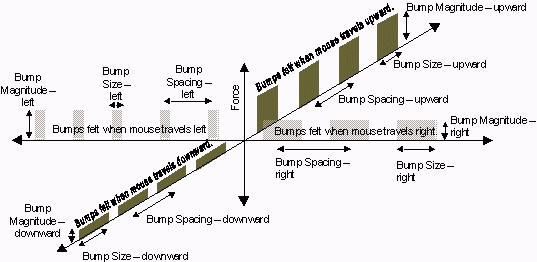Texture effects can simulate the grit of sandpaper, the ribs of a washboard, or the strings of a tennis racquet. Textures are often assigned to areas on the screen to make an object or background feel scratchy, grooved, grainy, or bumpy. A Texture is only felt when the mouse is moved.
Textures are composed of a series of speed bumps spaced at regular intervals. For each direction of mouse travel (left, right, up, and down) a different sensation can be defined. The following diagram shows a Texture that has different bump properties (width, height, and spacing) for each direction of travel.

In the three-dimensional coordinate system above, force magnitude is represented by the vertical axis. The other two axes represent direction of mouse travel. Imagine the mouse to be at rest in the center of the coordinate system (0,0,0). Now, if you move the mouse upward, you would feel the dark gray bumps depicted in the upper right. Likewise, if you move the mouse to the left, you would feel the light gray bumps on the left.
You can also play multiple Textures simultaneously, layered on top of one another, to create a more complex overall texture effect. When combined, the forces of Textures are additive up to the maximum possible force output level.
Axes
When it is created, a Texture can be defined as along the X-axis, the Y-axis, or both the X and Y axes. An X-axis Texture can be felt when the mouse travels left or right. In other words, you feel vertical stripes of bumps as you travel horizontally (along the X-axis). A Y-axis Texture can be felt when the mouse travels up or down. You feel horizontal stripes of bumps as you travel vertically (along the Y-axis). A double-axis Texture can be felt along any line of motion, though the stripes of bumps still lie along the X- and Y-axes.
The axes of the Texture cannot be changed dynamically once the effect is created.
Duration
The duration determines how long the Texture lasts.
Gain
Gain is a factor with which you can scale all the magnitudes of the Texture effect. It ranges from 0 to 10000, where a gain of 10000 is equivalent to multiplying the forces throughout the effect by a factor of 1.
Magnitude
Magnitude determines how much each bump is felt: the higher the magnitude the greater the force. There are separate magnitude values for the positive and negative directions of travel along an axis. The positive magnitude controls the magnitude when moving across the Texture down or to the right (in positive directions of travel). The negative magnitude controls the magnitude when moving across the Texture up or to the left (in positive directions of travel).
To create a velvet-like effect, you could supply non-zero bump magnitudes for only one direction of travel (e.g. the Texture would feel fuzzy when moving right, smooth when moving left). To create a grid-like effect, you could supply the same magnitude values for all directions of travel.
Offset
Offset specifies the pixel distance from the left and top edges of the screen or enclosure at which the first texture effect (bump) is felt. Use this property to line up the bumps of a Texture with features on the screen, e.g. so that the bumps correspond with lines or a grid drawn on the screen.
Spacing
Spacing determines how far apart the bumps are. It is the distance in pixels between the centers of two adjacent bumps. There is a positive spacing that denotes this distance when the mouse is moved down or to the right. There is also a negative spacing that denotes this distance when the mouse is moved up or to the left. By setting the positive and negative spacings to different values it is possible to make the Texture feel different in different directions of movement.
Thickness
The bump width, or Thickness, determines how wide the bumps are. It is the width of the bump in the direction of the Texture's axis. The positive thickness denotes the width when the mouse is moved down or to the right. The negative thickness denotes the width when the mouse is moved up or to the left.
<<
Back to your previous page
Immersion Support Index